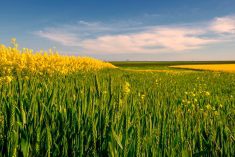Canola has been on quite a journey over the last week. The Canadian oilseed’s November contract on the Intercontinental Exchange closed at $658.20/tonne on July 5 after a series of gains.
Five days later, the November contract plummeted to $617.90/tonne after a round of sharp losses. Something of a reprieve was granted the next day, as the contract bumped up to $620.20.
At the heart of canola’s losses was a general sell-off in global oilseeds. Be it pressure from losses in Chicago soyoil, Malaysian palm oil or European rapeseed, canola had no choice in being dragged down.
Read Also

Manitoba boosts stake in cereals centre to $23.5 million
Premier Wab Kinew said the additional project funds will help ‘Trump-proof’ the provincial economy.
However, as canola seemed destined to test its psychological support level of $600/tonne, bargain hunting helped inspire something of a turn around, but canola was rangebound.
As the oilseed was set to run into resistance last week at about $670/tonne, this week its support level appeared solid. The question now is what next?
A week of hot temperatures across much of the Prairies during the week of July 8 provided the region’s crops with opportunity to catch up in development. Ample amounts of spring rain that almost eradicated two years of drought, combined with cooler-than-normal temperatures, limited the ability of canola and other crops to adequately flourish. The heat kicked those crops into overdrive, although some flowering canola was pushed a little to quickly, unable to tolerate the heat.
Nevertheless, things are shaping up for a pretty good canola harvest, albeit one that will likely be a little later than usual.
The issue at hand is weather. Will Mother Nature allow for good weather to keep the Prairies in good shape through to harvest, or will she let adverse conditions take hold? Many in the trade warn that it’s still too early to tell.
Continued good weather will invariably pressure canola lower, perhaps busting through its support level. A dramatic turn of events, something that brings great harm to crops, would generate a strong upward shift, maybe breaking through its resistance level.
All we can do is sit and wait.














